Best AI PC in 2024: Intel, AMD, and Snapdragon laptops with CPU, GPU, and NPU for tasks powered by artificial intelligence
Shopping for a new laptop? It only makes sense to check out the best AI PCs on the market today.
Buying what is considered an AI PC as your next laptop means that you're getting a system that can better handle AI tasks. While the usefulness of an AI PC hasn't yet reached a point where I'd recommend everyone rush out and buy one, those shopping for a great new laptop now can still take advantage and set themselves up well for the fast-moving world of AI.
AI PCs, as defined by Intel, require a Neural Processing Unit (NPU), which is a specific piece of hardware set aside for AI work, lessening the load on the processor (CPU) and graphics chip (GPU). Microsoft adds the necessity of a Copilot key on the keyboard in its definition of AI PC, and some options in this list feature the new dedicated input.
AI PCs really don't look any different from standard laptops, and most of the devices included here are laptops that have received regular refreshes for 2024, albeit this time with a CPU that includes an NPU. I've also included some of the best Copilot+ PCs tested and reviewed here at Windows Central, featuring Snapdragon X ARM64 chips and access to advanced AI features in Windows 11.
There are AI PCs for regular productivity work, there are AI PCs with high-end designs and features, and there are AI PCs built specifically for gaming and other demanding tasks. Out of all the laptops we've tested and reviewed, I've selected eight top options that should suit most people who are shopping for a great AI PC.
The quick list
I've collected the best AI PCs that we've tested in a quick list right here for easy reference. Hit the link for any of the laptops to read a full breakdown, including pros, cons, and review highlights.

Best 14-inch
Dell's XPS 14 (9440) is all-new for 2024, with a minimalist design, 3.2K OLED display, optional discrete NVIDIA Laptop GPU, and Intel Core Ultra H-series CPUs with NPU for boosted AI performance. It's a high-end 14-inch laptop that features a Copilot key on its lattice-free keyboard.
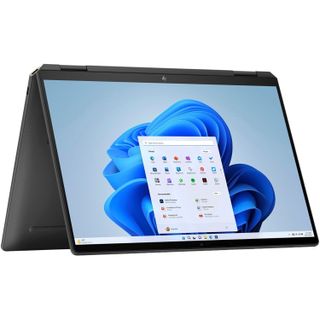
Best convertible
HP's Spectre x360 14 (2024) is a great choice for anyone who prefers a convertible laptop with the ability to rotate into tent, stand, and tablet modes. The premium laptop includes Intel Core Ultra H-series CPUs with NPU for AI tasks, as well as a 2.8K OLED touch display.
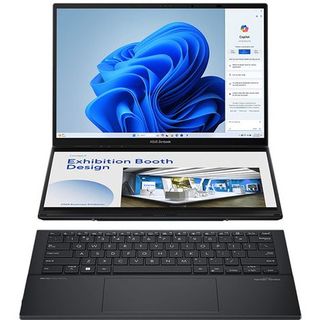
Best dual-screen
The ASUS Zenbook Duo blew us away with its smooth dual-screen operation with two high-res OLED touch displays. It's powered by Intel Core Ultra H-series CPUs with NPU, making it perfect for professionals and multitaskers who want to lean into AI tasks.

Best 16-inch
A 16-inch 3K OLED panel at 120Hz and all-day battery life are standout features, but this sleek Zenbook has AMD Ryzen AI 300 chips inside with stellar everyday performance and an NPU at 50 TOPS. If you'd like long battery life and extra power for AI tasks, this should be a top choice.

Best 14-inch gaming
Gaming laptops sized 14 inches are ideal for those who want to travel light, and the ROG Zephyrus G14 (2024) can even fit into a professional setting thanks to its overhauled design. It's powered by AMD's Ryzen 9 8040 CPUs with an included NPU, as well as up to an NVIDIA RTX 4070 Laptop GPU.
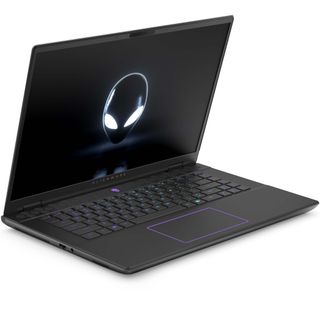
Best 16-inch gaming
The Alienware m16 R2 was overhauled for 2024 with a sleeker design and plenty of high-end features. It can handle gaming with ease thanks to the NVIDIA RTX 4070 Laptop GPU, and its Intel Core Ultra H-series CPUs feature an NPU for boosted AI performance.
Load the next products ↴

Best Windows on ARM
The Surface Laptop 7 is the culmination of years of refinements and tweaks. Now equipped with the Qualcomm Snapdragon X Elite ARM64 SoC, it's more powerful and longer lasting than ever. High-res touch displays in 13.8- and 15-inch sizes are available.
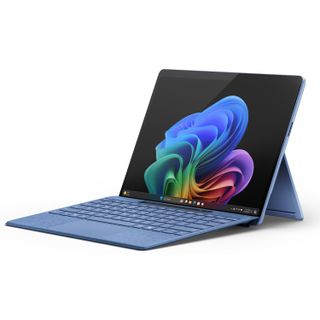
Best 2-in-1
Microsoft's flagship PC is now powered by Snapdragon X chips for unreal power and efficiency, and its 13-inch 2.8K touch display now has an OLED panel for better color and contrast. It's the most versatile option in this list thanks to the detachable design, but it's priced competitively for all users.
Our favorite AI PCs in 2024
Why you can trust Windows Central
With the quick list out of the way, we can now dig into each AI PC to detail its pros, cons, and why it might be a great fit for you. We've tested and reviewed all of these laptops favorably, and they all fit the "AI PC" definition set by either Intel or Microsoft. With a mix of Intel, AMD, and Qualcomm chips inside, there's a good range of pricing, features, and sizes for most users.
Best 14-inch laptop
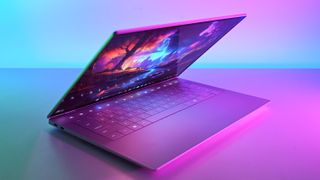

Specifications
Reasons to buy
Reasons to avoid
Dell's XPS 13 Plus from a couple of years ago featured a major redesign with a seamless haptic touchpad, a lattice-free keyboard with no gaps between keys, and capacitive touch function buttons along the top row. That design has now made its way into the rest of the XPS lineup, with Dell even changing the sizes for the larger models at 14 and 16 inches.
The XPS 14 (9440) is the new XPS 15, perfect for users who want the larger display in a chassis that would have been used for a 13-inch laptop just a few years ago.
Windows Central Editor-in-Chief Daniel Rubino reviewed the XPS 14 (9440), noting, "Besides the futuristic design, the XPS 14 brings a lot of power to what used to be Ultrabook territory. At 3.6 lbs (so not heavy nor light), it's about a pound heavier than most thin-and-lights, but in turn, you're getting a slightly less powerful miniature XPS 15 (4.23 lbs). That's awesome."
With a Copilot key on the keyboard, Intel Core Ultra H-series CPUs with NPU inside, and even an optional discrete NVIDIA RTX 4050 Laptop GPU to complement the integrated Intel Arc graphics, this is what Microsoft means when it says "AI PC." Battery life is just average when you add the discrete GPU, but that's really one of the only downsides.
The 14.5-inch display comes in a couple of options, starting with a more affordable FHD+ resolution that weighs less and boosts battery life. It's a great display in its own right, but a lot of people are going to want to make the jump to a 3.2K OLED touch display with 100% DCI-P3 color, 120Hz refresh rate, and HDR500 support.
Read our in-depth Dell XPS 14 (9440) review
Best convertible laptop


Specifications
Reasons to buy
Reasons to avoid
Dell and HP often battle for the top spot when it comes to our favorite overall laptops. For anyone who wants a top convertible laptop, the HP Spectre x360 14 (2024) is an easy recommendation.
It's a premium device throughout, as evidenced by the sleek design, accented corners, and smooth aluminum chassis. The keyboard is one of the best in the business (I'm using an HP Spectre x360 16 to type this right now ... I can't get enough), and the massive haptic touchpad offers precision pointing and even some configurable shortcuts for volume and screen brightness.
HP offers up to an Intel Core Ultra 7 155H CPU with integrated Arc graphics, as well as an NPU, for a boost to AI tasks. The laptop lacks a dedicated Copilot key, but it otherwise adheres to Microsoft views as an AI PC.
It's all topped off with a 14.5-inch touch display with a 2880x1800 (2.8K) resolution, OLED panel, 120Hz variable refresh rate, 100% DCI-P3 color, and 500 nits brightness with HDR enabled.
Windows Central Staff Writer Zachary Boddy noted in their HP Spectre x360 14 review that "You'll never get tired of using it, you'll never have to wait for it to catch up, and you'll never have to stress about leaving the house without your charger."
Read our in-depth HP Spectre x360 14 (2024) review
Best dual-screen laptop
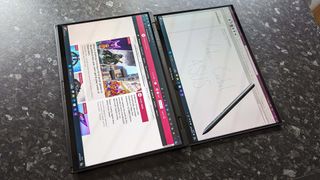

Specifications
Reasons to buy
Reasons to avoid
The ASUS Zenbook Duo absolutely blew me away when it arrived, and I've loved every second with it. Before using it, I thought that dual-screen laptops were mostly a gimmick, but it has me converted.
Windows Central Editor Ben Wilson feels the same way, awarding it full marks in his Zenbook Duo review. It's not perfect — the webcam is weak, and it's thicker than your average 14-inch laptop — but it's an incredible tool for multitaskers and professionals who can benefit from having two screens ready to go at any time with minimal setup.
It's a laptop that looks like pretty much any other except for its magnetic keyboard and touchpad, which can be removed as a separate piece of hardware for wireless use. This reveals a second 14-inch 3K OLED touch display with a 120Hz refresh rate to match the main screen; pop out the sturdy stand on the back, and you have a versatile PC that stands on its own with two displays ready to go.
Battery life is very impressive, especially if you're only using one screen, and the performance is relatively snappy. It won't beat a lot of single-screen laptops with the same performance hardware, but the tradeoff is so big that won't matter for a lot of users.
ASUS offers up to an Intel Core Ultra 9 185H chip with integrated Arc graphics and an NPU for AI work, though it does lack a dedicated Copilot key. Speaking of the removable keyboard, there were no sacrifices for ASUS to make, thanks to deep 1.4mm key travel and a sizable Precision touchpad.
Read our in-depth ASUS Zenbook Duo review
Best 16-inch laptop


Specifications
Reasons to buy
Reasons to avoid
The ASUS Zenbook S 16 (UM5606) is the first laptop we tested that uses new AMD Ryzen AI 300 chips. It's available with the Ryzen AI 9 365 or more powerful Ryzen AI 9 HX 370, both with an NPU that hits 50 TOPS of power for local AI acceleration. In mobile chips, that's as good as it gets, even besting Qualcomm Snapdragon's 45 TOPS. That's enough for Copilot+, and these laptops are expected to get access to the advanced AI features later this year or early next year.
Our review unit had the higher-tier HX 370 CPU inside, and it performs very well. It even bested the Core Ultra 9 185H chip in the Zenbook Duo in this list. The laptop hit more than 13 hours in PCMark 10's Modern Office rundown test, and that should come out to around 9 or 10 hours of real-world runtime.
The 16-inch display is color-accurate, with 100% sRGB, 100% DCI-P3, and 94% AdobeRGB reproduction in our testing. It hits up to 375 nits brightness, but you'll be wishing for a less glossy finish if you're working in sunlight. Nevertheless, the OLED panel with 2880x1800 resolution, 120Hz refresh rate, and 0.2ms response time is a stellar pickup at the asking price.
In his ASUS Zenbook S 16 (UM5606) review, Windows Central Editor Ben Wilson said:
"What stands out the most for ASUS is the fantastic value, starting from only $1,399.99 at Best Buy to bag a 120Hz OLED screen with a color-accurate display, albeit one that performs best indoors and away from natural sunlight is a total bargain when you also factor in the all-day battery life."
Read our in-depth ASUS Zenbook S 16 (UM5605) review
Best 14-inch gaming laptop
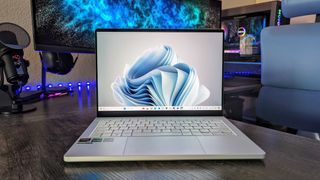

Specifications
Reasons to buy
Reasons to avoid
The ASUS ROG Zephyrus G14 (2024) offers respectable gaming performance in a slim chassis that's easier to carry around than more traditional 16-inch gaming devices.
It was redesigned for 2024, resulting in a more streamlined approach with an aluminum design and an understated look. It's slim, it's sleek, and it offers high-end keyboard, touchpad, and speakers.
Inside is an AMD Ryzen 9 8945HS CPU with AI Ryzen NPU managing 16 TOPS of AI-specific performance. That's better than what's currently found in Intel's first run of Core Ultra chips, and AMD is expected to triple that performance in its next-gen CPUs.
The Ryzen CPU is paired with up to an NVIDIA RTX 4070 Laptop GPU for strong gaming power, but the PC's modern design also makes it suitable for creative and design work. It will get hot to the touch when under prolonged load, but it runs without major throttling thanks to intelligent power balancing. Battery life goes from about two or three hours when gaming up to about six hours for lighter tasks.
The 14-inch OLED display is gorgeous, with a 2.8K resolution, 120Hz refresh rate, 500 nits brightness with HDR enabled, 100% DCI-P3 color reproduction, and NVIDIA G-Sync compatibility.
Staff Writer Zachary Boddy remarked in their ASUS ROG Zephyrus G14 (2024) review that "ASUS set out to perfect its 14-inch gaming laptop and kissed the feet of sublimity with the latest version." It might not have a dedicated Copilot key, but it should otherwise be considered one of the best AI PCs out there right now.
Read our in-depth ASUS ROG Zephyrus G14 (2024) review
Best 16-inch gaming laptop
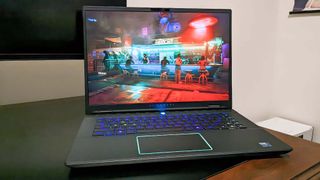

Specifications
Reasons to buy
Reasons to avoid
As far as 16-inch gaming laptops go, the Alienware m16 R2 is one of the best we've ever tested. If you prefer a larger display with Intel and NVIDIA performance hardware, it should be hard to pass up.
In her Alienware m16 R2 review, Editor Rebecca Spear said, "Its performance and how long the battery can last when running average office programs thoroughly impressed me. For this reason, the laptop will serve you well if you need to use it for work, school, and video games."
Thanks to Intel's Core Ultra H-series CPUs (up to an Ultra 9 185H), you're getting an NPU for boosted AI performance. The laptop can also be configured with up to an NVIDIA RTX 4070 Laptop GPU, which will also help with AI apps that lean on the graphics card (looking at you, Adobe).
Other review highlights include the generous selection of ports, customizable RGB lighting, strong battery life outside of gaming, and the sleek redesign that makes it more compact than its predecessor.
It would be nice to have more screen brightness, but the QHD+ display is otherwise impressive for gaming with 240Hz refresh rate, 3ms response time, G-Sync support, and 99% sRGB color.
Read our in-depth Alienware m16 R2 review
Best Windows on ARM
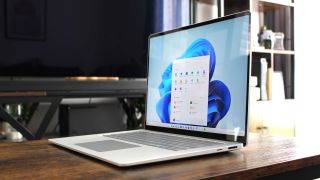

Specifications
Reasons to buy
Reasons to avoid
One of the biggest criticisms of past Surface Laptop models involved the design. It wasn't poorly designed — quite the opposite — but new models often didn't make any major changes to help sell the fresh hardware. This was true for both sizes of the laptop.
That's changed with the Surface Laptop 7 Copilot+ PC. The new model has thinner display bezels, rounded corners on the display, an upsized touchpad using Sensel haptics, an angled underside, and clean edges. It's now even easier to replace parts, and Microsoft sells the hardware directly.
The Laptop 7 still doesn't have OLED panels, but its IPS screens are impressive. The 13.8- and 15-inch sizes have the same 201 pixels-per-inch, 3:2 aspect ratio, 120Hz dynamic refresh rate, and Dolby Vision IQ support. They even max out around 600 nits brightness. I just wish it had an anti-reflective coating.
Typing and pointing are top-notch, the speakers have Dolby Atmos, and the Qualcomm chips offer tons of power and long battery life. Windows Central Senior Editor Zac Bowden reviewed the Surface Laptop 7, noting on the subject of emulated app performance:
"On older generations of Windows on Arm chips, running even basic apps under emulation felt slower than running an Intel or AMD machine. That's no longer the case here on Snapdragon X. Many of the apps I've tried that run under emulation feel fine, with no scrolling lag or frame dropping when navigating through an app."
The Surface Laptop 7 Bowden tested hit 18.5 hours in PCMark 10's Modern Office rundown, and you should expect anywhere from 12 to 15 hours of runtime in a real-world situation.
Read our in-depth Surface Laptop 7 review
Best 2-in-1


Specifications
Reasons to buy
Reasons to avoid
This 2-in-1 laptop "is the most exciting version since the original Surface Pro," according to Windows Central Editor-in-Chief Daniel Rubino in his Surface Pro 11 review.
That's mostly thanks to the inclusion of Qualcomm's Snapdragon X Elite (X1E-80) and Plus SoCs with strong performance and impressive efficiency, but there are some other goodies that help sell the PC. The core 2-in-1 design remains the same, offering tons of versatility as a tablet or as a laptop, but there's a new Pro Flex keyboard with wireless capabilities, a Sensel haptic touchpad, and a more rigid core to help with wireless use.
The Pro 11 now also has an optional OLED display. The 13-inch 2880x1920 panel works dynamically between 60Hz and 120Hz, it supports VESA DisplayHDR 600 and Dolby Vision, and it hit 100% sRGB and 96% DCI-P3 color reproduction in our testing. If you'd like to spend less, the usual touch IPS display is still available.
Performance and battery life are both stellar. The X Elite (X1E-80) chip we tested even pulls ahead of the Core Ultra chip in the XPS 14 and XPS 16, with no real performance slowdown when you unplug the PC. The Pro 11 averaged about 10 hours of runtime from a charge, hitting as high as 15 hours with mixed work.
Read our in-depth Surface Pro 11 review
How to choose the best AI PC for you
We're at a point already where it's almost impossible to shop for a new laptop without coming across at least a few that are considered AI PCs, and indeed it looks like six of the eight listed here that we've reviewed and tested are refreshed versions of older non-AI PCs.
The ASUS Zenbook Duo and Zenbook S 16 are the exceptions. The former is a completely new dual-screen laptop that I strongly recommend for any multitaskers who want the convenience of two displays in one laptop. The latter is a beautiful 16-inch creator laptop using AMD's new Ryzen AI 300 chips.
As for more traditional laptops, the XPS 14 (9440) is a premium option that fits Microsoft's definition of an AI PC. It received the futuristic redesign that we first saw in the XPS 13 Plus and features Intel's Core Ultra H-series CPUs with NPU for boosted AI performance. It's configurable with discrete NVIDIA RTX graphics, and it has a high-res OLED display option with accurate color reproduction.
If you're more interested in a convertible laptop, the HP Spectre x360 14 (2024) is one of the best that we've ever tested. It, too, is powered by Intel's Core Ultra H-series CPUs featuring an NPU, and it boasts a 2.8K OLED touch display.
For high-end gaming laptops, the ASUS ROG Zephyrus G14 (2024) and Alienware m16 R2 are both standouts from recent reviews. They've both received overhauls for the new generation, and they can both deliver a high-end gaming experience from display to keyboard to performance hardware inside.
We've now also begun testing and reviewing Copilot+ PCs powered by Qualcomm's Snapdragon X Elite and X Plus ARM64 chips. The Surface Laptop 7 and Surface Pro 11 have long been some of our favorite Windows laptops, and this year's refresh with Snapdragon X has pushed them into a new class with all-day battery life and snappy performance on or off the charger.
What is an AI PC?
The definition of "AI PC" is still murky, but Intel and Microsoft have been leading the way so far in attempting to set guidelines.
Intel says an AI PC requires a modern CPU, GPU, and NPU with AI acceleration capabilities, while Microsoft adds Copilot software and a Copilot key on the keyboard as requirements.
The NPU is a new addition designed specifically to perform AI tasks, helping take some of the load off of a system's CPU and GPU. While a GPU is still used, in many cases, for AI acceleration, more general AI tasks can absolutely benefit from the NPU.
We know that Copilot+ features in Windows 11 require at least 40 TOPS (Tera Operations per Second) of NPU power, which is so far only possible with Snapdragon X and AMD Ryzen AI 300 chips. Unfortunately, Qualcomm has some sort of exclusive deal with Microsoft, and you'll only find Copilot+ on PCs with a Snapdragon chip. That's expected to change later this year or early next year.
We know that Intel's "Lunar Lake" processors will have an NPU with 48 peak TOPS, but the chips aren't yet available in laptops. On NVIDIA's side, it claims that a bunch of its RTX-powered laptops will soon be able to run Copilot+.
What's the difference between Copilot+ PCs and AI PCs?
AI PCs have been around for a while, but Copilot+ PCs have arrived to shake things up (and make things more complicated for buyers). The difference between Copilot+ PCs and AI PCs ultimately comes down to NPU performance and access to certain AI features.
In a general sense, an AI PC has a CPU, GPU, and NPU designed for local AI acceleration. This includes PCs with a discrete GPU with specific cores for AI, but it also includes laptops with modern Systems-on-Chip (SoC). Laptops with Intel, AMD, NVIDIA, and Qualcomm hardware can be considered AI PCs.
Copilot+ was announced by Microsoft as a term for new AI features in Windows as well as the laptops capable of running them locally. The new AI features — including Windows Recall, Live Caption, enhanced local Cocreator, improved Windows Studio Effects, Auto Super Resolution, and more — are only available on PCs with an NPU capable of at least 40 TOPS. And due to some sort of exclusive deal between Qualcomm and Microsoft, the Snapdragon X Elite and X Plus chips are currently the only options for Copilot+ despite chips from AMD and Intel catching up with TOPS count.
What AI PC is best for students?
Students of all ages are headed back to school, and the lure of an AI PC is undoubtedly tempting. The uses for AI in your laptop are still what I'd consider limited, but the tools continue to improve and I admit that I often tap in for some quick help when writing, taking notes, or brainstorming.
If I'm recommending an AI PC for the average student, it's likely going to be one with a Qualcomm Snapdragon X SoC inside. Something like the Surface Pro 11 or Surface Laptop 7 provides all-day battery life, snappy performance even on DC power, high-end touch displays, and sleek designs. They're perfect for long days of lectures and labs, and they're easy to carry around in a backpack.
For students who require discrete graphics performance or who don't want to fiddle with ARM64 emulation, I'd suggest taking a look at the ASUS ROG Zephyrus G14, the Dell XPS 14, or even the ASUS Zenbook S 16 (though it lacks a discrete GPU).
Do you really need an AI PC?
Most people don't need to rush out and buy an AI PC at this point, but anyone shopping for a new device might find it hard to avoid a system with an NPU. Intel, AMD, and Qualcomm chips have saturated the market, and the new Copilot+ PCs will be tempting for anyone who values performance and efficiency. There's a good chance that you'll end up buying an AI PC anyway even if you don't set out with the specific goal in mind.
The usefulness of an AI PC is only going to increase as we see more apps and operating systems integrate AI, so it's not a bad idea to at least consider one of these laptops as your next device.
Get the Windows Central Newsletter
All the latest news, reviews, and guides for Windows and Xbox diehards.

Cale Hunt brings to Windows Central more than eight years of experience writing about laptops, PCs, accessories, games, and beyond. If it runs Windows or in some way complements the hardware, there’s a good chance he knows about it, has written about it, or is already busy testing it.